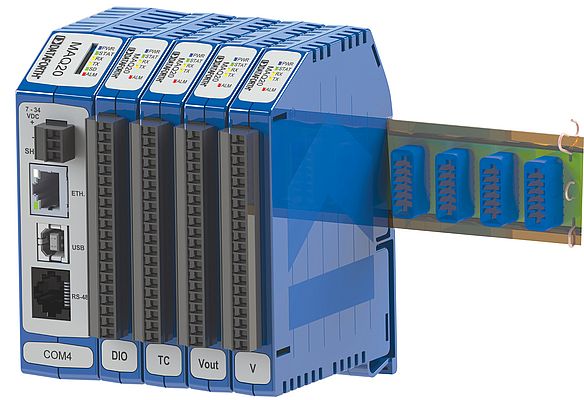A DIN rail mounted, programmable, multi-channel, industrially rugged signal conditioning I/O and communication module, the MAQ 20 is developed by Dataforth Corporation for a wide range of applications including factory and process automation, machine automation, military and aerospace, power and energy, oil and gas, and environmental monitoring. Just one communication module can interface to up to 24 I/O modules to create a system with as many as 384 channels that fits within a standard 19” instrumentation rack. Each I/O module has a 1500Vrms isolation barrier between the field-side and system-side wiring while some models offer per-channel isolation. All field wiring terminals are heavily protected against overload and accidental connection of incorrect signals, as well as ESD. Communication modules are offered in two models covering the standard industrial buses Ethernet, RS-232, RS-485, and USB with host software interfaces to the system using Modbus TCP/IP or RTU protocol. Analog input modules interface to a wide range of standard industrial sensors and equipment and offer up to 16 channels of input, each of which can be independently configured. Process voltage, process current and thermocouple input modules offer 8-channel differential input or 16-channel single-ended input for precise measurement of voltage and current signals. They also offer 8-channel measurement of five thermocouple types including accurate cold junction compensation and linearization. All channels are individually configurable for range, alarm limits, and averaging. RTD Input Modules interface to 2- or 3-wire sensors including six RTD types and potentiometers. Modules offer six channels, each configurable for range, alarm limits, and averaging. Strain gage input modules connect to full bridge sensors, have narrow or wide bandwidth filtering and offer four channels, each configurable for range, alarm limits, and averaging. Frequency input module accepts zero crossing and TTL signals with frequencies of 500Hz to 100kHz and provides a DC stimulus for contact sensors. This module has four channels, each configurable for range and alarm limits. Analog process current or voltage output models are used to drive valves, perform other crucial process operations, and provide up to eight channels of 300Vrms channel-to-channel isolated output, which can be independently configured. Discrete I/O modules provide five channels of input and five channels of output per module and offer special functions as well as alarm capability. They accept 3 to 60VDC input and provide 3 to 60VDC output at 3A, or 90 to 280VAC/VDC input and 24 to 280VAC output, also at 3A. The system backbone resides within the DIN rail used for module mounting and provides power to and data interface between the communication module and the I/O modules. Key system features include ±0.035% accuracy, –40°C to +75°C operating temperature, 50ppm/°C typical stability of reading, process-oriented communication, 240 Vrms continuous input protection, ANSI/IEEE C37.90.1 transient protection, ReDAQ shape monitoring & control software, and RoHs compliance. To power the system, a 7-34VDC power source is connected to the communication module. Regulated and protected supplies within the module then provide power both to the internal circuits and to all modules in the system. When many high power I/O modules are used in a system, load-sharing power boost modules can be installed in standard I/O module slots to provide the necessary additional power. The system is supported by the company’s ReDAQ Shape for MAQ 20 out-of-the-box software that enables users to create, save, and open graphical user interface projects for test, process, data collection and data analysis applications. It also provides the most effective way to configure and customize MAQ 20 functions for specific application requirements. Just three easy steps are required to create data acquisition and control projects, and toolbox tools are easily moved, re-sized, cut, copied, pasted, and deleted.

















